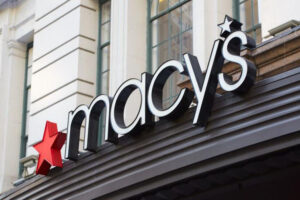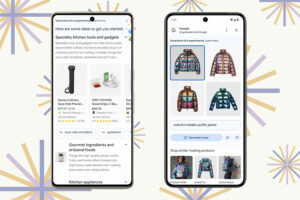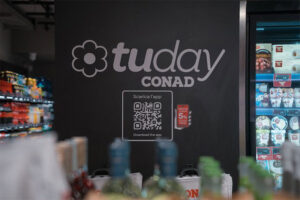A Sip and a Story
Total Wine and More uses digital signage to bring product information to life
With wine, spirits and beer, says John Jordan, facts tell — but the story sells. Engage an enthusiast with a tale about grapes from a particular region, introduce him to a craft brewery or offer tips about pairing food and drink, and that customer may well be ready to buy. Especially if the story is presented in a digitally attractive way in close proximity to the product.
In 2012, Jordan, senior vice president of customer experience and chief customer officer of Total Wine and More, came across the booth for managed network services and solution provider Hughes at Retail’s BIG Show in New York.
At the time, the Bethesda, Md. based retailer had a content delivery strategy that Jordan says was “in test mode, and small scale.
“I wasn’t actively looking for a solution at the time,” he admits. But seeing what Hughes was doing for other retailers — and realizing the company was based about 30 minutes from Total Wine headquarters — Jordan set a meeting, and a partnership was born.
As part of an overall customer engagement strategy, Total Wine has worked with Hughes to install dynamic digital signage across its more than 125 stores in 18 states. The company now has roughly 40 hours of proprietary video with an average segment length of 60 seconds.

Total Wine and More has installed dynamic digital signage across its more than 125 stores.
The system, programmed through a web interface, allows Total Wine to play individual videos only in the regions where the products are available. Each location has an average of three screens as well as in-store kiosks. Some stores include a wine-and-food-pairing kiosk, with the same pairing ability available in an app, to help customers explore new options.
“Too often in the wine industry, the focus is on numbers and ratings, and sugar levels and alcohol levels,” Jordan says. “But a growing cohort of consumers cares less about that. They care about the person behind the wine, the region from which it came, the history of the winemaker. It’s all about the romance of the product.”
Ease of use
“There is a higher expectation now from consumers, just because information is so accessible, regardless of what the product category is,” says Ricardo Belmar, director of product marketing and product management for Hughes.
“Most of us have been trained and spoiled by our smartphones. Any time I want, I can pick up a device and find any information I want. So when I go into a store … I probably have the expectation that it should be a richer experience than if I’m just at home with my smartphone or tablet. If I’m going to a store that specializes in a product, I’m expecting some guidance. And I’m expecting more information, more easily accessible, than if I looked for it myself.”
The Hughes system not only provides a richer experience for customers; it also offers ease of use for store employees.
“We can change programming in a particular store or group of stores at the last minute if we learn a winemaker is in the area and can entertain a tasting,” Jordan says. “The last thing we want is an Italian producer playing on the television when there’s a French producer [in the store] pouring wine.”
An increasing number of customers watch the videos — and when a particular wine is featured, the staff receives many more inquiries about it.
Because the effort was part of a larger strategy that also included a new loyalty program, Jordan is unable to provide specific return-on-investment figures. An increasing number of customers watch the videos — and when a particular wine is featured on the screens, the staff receives many more inquiries about it.
The installation has had enough of an impact for Total Wine to work with Hughes on planning the next iteration: interactive video, where customers can choose what they want to see. Future plans focus on the screens in the stores’ educational areas, allowing customers to choose which products and regions they want to learn more about.
Jordan has seen particular interest in the store section called the Brewery District, which features some 2,500 different beers. Craft brewers are often “very entertaining,” he says, “and customers will stand there in front of the screen and watch the whole thing … . What ‘TWM TV’ is helping us deliver is more commensurate with the experience these customers are getting in other retail and on-premise environments.”

In the future, Total Wine plans to focus on digital screens in the stores’ educational areas, allowing customers to choose which products and regions they want to learn more about.
Network capabilities
Though each customer is unique, Belmar says, there were certain advantages in working with Total Wine compared with other retailers. Since the company has an entire team focused on the customer experience, it was easier to get all involved parties to the table and consider what elements of the business might be affected.
What’s more, “The type of product they sell really lends itself to a richer source of knowledge,” Belmar says. “If you’re a serious wine connoisseur, you want to know every little detail about the wine, such as where was the particular patch of land where the grapes used to fill this bottle were grown, because it’s going to impact the flavor.”
The process for working with Total Wine included much discussion of the store’s customers, and what they wanted the store experience to be.
“You have to have that vision to start with before you worry about what technology you’re going to use to deliver it,” Belmar says. “Depending on what your objective is for the experience, the answer may be digital signage. Maybe it’s a mobile device, maybe a mobile app the customer downloads, or maybe it’s having the store associates have a device with a product information app on it and a great Wi-Fi connection.
And maybe it’s a combination of those things.”
A discussion of any store’s network infrastructure also has to be part of the plan. Questions must be asked about how much bandwidth is already available, and whether it can handle additional requirements. A few years ago, retailers may have asked whether they really needed Wi-Fi, but now the question is how it can be improved.
Hughes is preparing to release a network ROI tool in partnership with EKN Research that will allow companies to determine whether their networks are capable of supporting new digital experience initiatives, including the potential impact on revenue.
“What I tell retail customers we work with is that we have a different philosophy than other providers of the same technology,” Belmar says. “We believe you have to work together, in partnership, to fully develop the experience so you have the kind of engagement you intended with the shopper.”
He mentions work Hughes has done with outdoor retailer Cabela’s, for example, with touchscreens of various animals that include maps, sound effects and more.
“Generally speaking, retailers are realizing that this is the new normal,” Belmar says. “These are the standards that they’re all going to be compared against. Consumers expect an Apple or Uber experience everywhere.”



